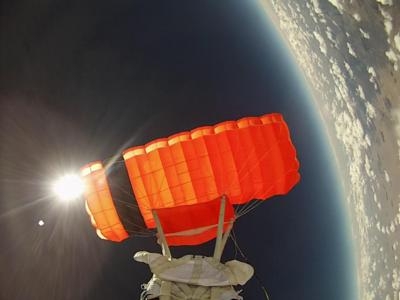Wed, Feb 25, 2015
World View, United Parachute Technologies Successfully Fly Parafoil At 102,200 Feet
Commercial Balloon spaceflight company World View says it is one step closer to launching manned voyages after successfully flying the first parafoil from the edge of space at a record-breaking height of 102,200 feet Friday morning.

With extremely limited air pressure and density at this high altitude, flying a parafoil is an incredible feat. This achievement signifies a major milestone for World View as this is the same altitude at which future manned flights will transition to the parafoil, which will be responsible for easing passengers gently down to Earth from the stratosphere. While World View has flown high-altitude balloons to this height before, this is the first time a parafoil has been flown at the edge of space.
With this flight, World View announces a partnership with United Parachute Technologies (UPT) in conjunction with Performance Designs, which co-designed the breakthrough technology and will provide parafoil systems for both unmanned research flights and journeys to the edge of space. As the global leader in parafoil and recovery systems, UPT brings decades of experience and expertise to help World View accelerate forward and continue to make breakthroughs in technology. In the months ahead, UPT will work closely with World View's aerodynamic systems team to design and build an advanced descent system capable of returning payloads of increasingly higher masses.
"The accomplishments of this flight further our two main objectives of manned spaceflight and advancing research," said Taber MacCallum, World View's Chief Technology Officer. "The successful flight of the parafoil at this altitude brings us closer to flying private citizens safely to the edge of space and also allows us to continue our research and education program by providing safe access to the near-space environment."
This flight's payload contained experiments from two universities. Montana State University tested a computer system designed to achieve increased reliability in extreme environments as well as a low-cost tracking and high-definition video link, which they hope to use to capture the 2017 solar eclipse on video. The University of North Florida flew experimental technology to measure the ozone gas profile in the stratosphere using a nanocrystalline gas sensor array. All three experiments are a result of student efforts over multiple years. The research and education payloads flown by World View are part of the company's commitment to opening routine access to high-altitude balloon flights as well as its dedication to advancing STEM programs in schools.
(Image provided by Worldview Experience)
More News
From 2014 (YouTube Version): One Of The Airshow World's Pre-Eminent Formation Teams Chats About The State Of The Industry At EAA AirVenture 2014, ANN News Editor Tom Patton gets th>[...]
Tactical Air Navigation (TACAN) An ultra-high frequency electronic rho-theta air navigation aid which provides suitably equipped aircraft a continuous indication of bearing and dis>[...]
Aero Linx: Doobert Hi, we're Chris & Rachael Roy, founders and owners of Doobert. Chris is a technology guy in his “day” job and used his experience to create Doobe>[...]
The Airplane Was Spinning In A Nose-Down Attitude Before It Impacted Terrain On June 20, 2025, at 0900 eastern daylight time, a Pitts Aerobatics S-2B, N79AV, was destroyed when it >[...]
Also: United Elite Sues, Newark ATC Transitions, Discovery Moves?, Textron @ KOSH The Commemorative Air Force Airbase Arizona is taking its “Flying Legends of Victory Tour&rd>[...]
 Classic Aero-TV: Up Close And Personal - The Aeroshell Aerobatic Team at Oshkosh
Classic Aero-TV: Up Close And Personal - The Aeroshell Aerobatic Team at Oshkosh ANN's Daily Aero-Term (07.13.25): Tactical Air Navigation (TACAN)
ANN's Daily Aero-Term (07.13.25): Tactical Air Navigation (TACAN) ANN's Daily Aero-Linx (07.13.25)
ANN's Daily Aero-Linx (07.13.25) NTSB Prelim: Pitts S2
NTSB Prelim: Pitts S2 Airborne 07.09.25: B-17 Sentimental Journey, Airport Scandal, NORAD Intercepts
Airborne 07.09.25: B-17 Sentimental Journey, Airport Scandal, NORAD Intercepts



